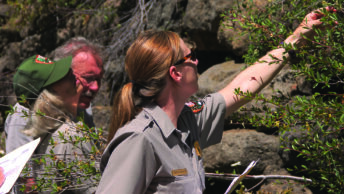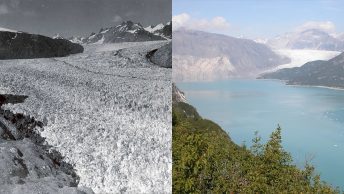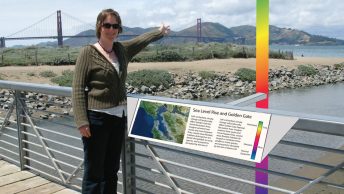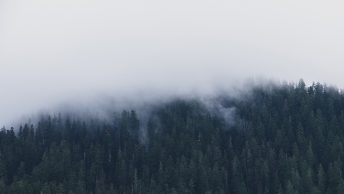Jon C. Day, Scott F. Heron, Adam Markham
Abstract
Climate change is the fastest-growing global threat to the world’s natural and cultural heritage. No systematic approach to assess climate vulnerability of protected areas and their associated communities has existed—until now. The Climate Vulnerability Index (CVI) is scientifically robust, transparent, and repeatable, and has now been applied to various World Heritage properties. The CVI builds upon an established Intergovernmental Panel on Climate Change (IPCC) framework to systematically assess vulnerability through a risk assessment approach that considers the key values of the World Heritage property in question and identifies key climate stressors. The CVI process is then used to assess the climate-related vulnerability of the community (including local residents, domestic visitors, and international tourists) associated with the World Heritage property considering economic, social, and cultural connections. Climate impacts are increasingly adding to a wide range of compounding pressures (e.g., increasing tourism, infrastructure development, changing land use practices) that are affecting places, people, customs, and values. Applications of the CVI to date have led to commitments to integrate outcomes into relevant management plans, and to periodically repeat the process, enabling responsive management to changing future circumstances. The CVI has also demonstrated its potential applicability for protected areas beyond World Heritage properties. The CVI process engages local community members in determining impacts, provides opportunities for identifying adaptation and impact mitigation within the community, and aids broader communication about key climate issues.
Introduction
Climate change is the fastest-growing threat to heritage—both natural and cultural—including heritage in all types of marine and terrestrial ecosystems worldwide (Osipova et al. 2017; ICOMOS 2019). Climate impacts are increasingly adding to a wide range of other compounding pressures (e.g., increasing tourism, infrastructure development, changing land use practice) that are affecting places, people, species, ecosystems, customs, and values (Markham et al. 2016). However, there has not been, until recently, a tool to systematically assess climate change across a broad range of protected area types.
The Climate Vulnerability Index (CVI) has met this need. The CVI is a rapid assessment tool initially created to assess climate change vulnerability in all types of World Heritage properties—natural, cultural, and mixed. It is a comprehensive approach that balances scientific robustness and credibility with a level of practicality that can be undertaken in a variety of rapid delivery modes (from an abbreviated 2–3-hour CVI Snapshot by managers, up to a comprehensive multi-day CVI Workshop of diverse stakeholders). The transparency of the process is such that it can be readily repeated to assess trends at the same site over time. The framework can also be applied to assess climate vulnerability of other types of protected areas.
Climate change and World Heritage
There are over 1,100 World Heritage properties in 2019, considered “the best of the best” globally. Many of these properties are already experiencing significant negative impacts and damage from climate change (see Table 1). Examples in natural systems include:
- Bleaching events driven by marine heat waves have increased and are projected to become more frequent and severe for the 29 natural World Heritage sites that contain tropical coral reefs (Heron et al. 2017); this is likely to lead to massive changes to coral reef ecosystems.
- Increases in atmospheric temperatures have driven the loss of glaciers worldwide in both mountain and polar regions, with further loss projected this century under current emissions practices (Bosson et al. 2019).
- Terrestrial biodiversity is being affected with the shifting of species’ geographic ranges, changes in the timing of biological cycles, modification of the frequency and intensity of wildfires, migration of pests and invasive species, etc. (Pecl et al. 2017)
World Heritage cultural sites are also threatened by climate change; for example:
- Of the 49 coastal cultural World Heritage sites in the Mediterranean, 47 are likely to be negatively affected by flooding and/or coastal erosion due to sea-level rise by 2100 (Reiman et al. 2019)
- Many cultural World Heritage properties that are popular tourist attractions have been identified by UNESCO (United Nations Educational, Scientific, and Cultural Organization) and others as at risk from climate change, including the Statue of Liberty, USA; Rapa Nui (Easter Island), Chile; Stonehenge, UK; and Venice, Italy (Markham et al. 2016).
- Many types of built heritage (e.g., ancient and modern structures) are being impacted by a wide range of climate stressors. Climate stressors are also causing degradation or loss of other types of tangible heritage (e.g., physical artefacts, archaeological material) and intangible heritage (e.g., cultural practices, traditional knowledge; UNESCO 2007; ICOMOS 2019).
The severity of current climate impacts on individual World Heritage properties varies, as do the range of climate change stressors causing them and the rates at which impacts are occurring. In most cases, the consequence of climate change is a decline in the values that collectively comprise the reason they were listed as World Heritage: their Outstanding Universal Value (OUV). In recent years, the World Heritage Committee has become increasingly concerned about climate change impacting properties around the world, but no process has existed to adequately cope with climate change in a systematic way for all types of heritage.
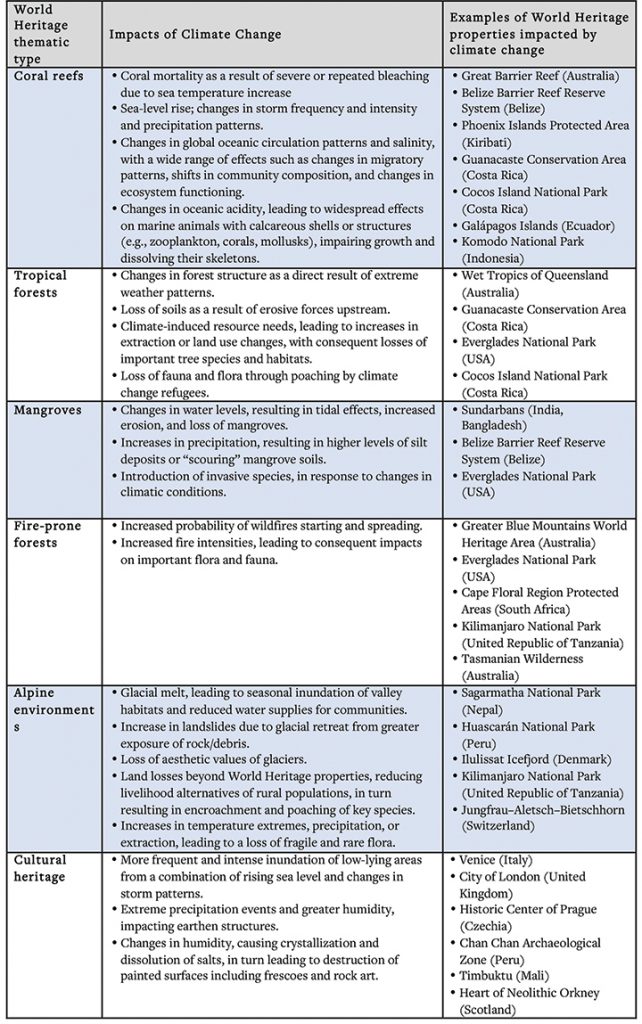
The first two authors of this paper developed the initial CVI framework for application to World Heritage. The CVI built upon a vulnerability framework described by the Intergovernmental Panel on Climate Change (IPCC 2007). Input and guidance for the CVI were provided by various colleagues from James Cook University, the Commonwealth Scientific and Industrial Research Organisation (CSIRO), and other Townsville-based entities, and subsequently from other colleagues around the world, including from the International Council on Monuments and Sites (ICOMOS) and the International Union for Conservation of Nature (IUCN), two of the advisory bodies for the World Heritage Committee.
Applying the CVI to World Heritage
The CVI uses a risk assessment approach and comprises two distinct stages (Figure 1):
- OUV Vulnerability, assessing potential impacts on the key values for which the property is recognized; and
- Community Vulnerability, based on economic, social, and cultural connections of the associated community (local, national, and international) with the World Heritage property, the dependency of the community upon the property, and the capacity of the community to adapt to climate change.
Both of these vulnerability assessments are highly relevant for key stakeholders, including site managers, responsible management agencies, businesses that are dependent on the property, and local communities around the property. The Community Vulnerability assessment builds upon work by Marshall et al. (2013) to provide a useful tool for comprehensively assessing potential impacts on communities and the adaptive capacity of those communities.
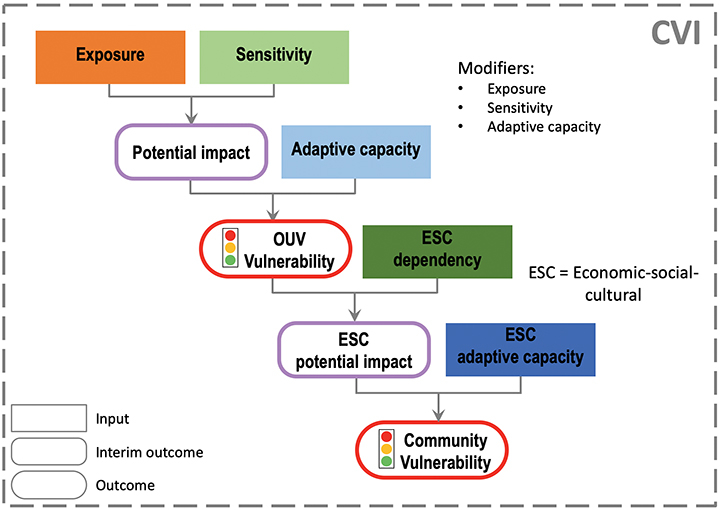
The CVI process is best undertaken through a workshop of diverse stakeholders (including site managers, researchers, community representatives, dependent business owners, management agency representatives, and other stakeholders) that systematically undertakes the steps outlined below. Further information about the CVI methodology is provided in the Supplementary Material ; a comprehensive description of the CVI methodology and its application are available in a report by Historic Environment Scotland assessing climate risk for Heart of Neolithic Orkney World Heritage Site (Day et al. 2019).
The workshop begins by undertaking three foundational steps:
- Summarize the elements of UNESCO’s official statement describing the World Heritage property’s OUV into a list of specific key values;
- From a compiled list of climate stressors (see Tables 2 and 3) determine the three likely to have the greatest impact on the key values within an agreed-upon timeframe; and
- Undertake a preliminary assessment of the current condition of and trend in the key values since the inscription of the property on the World Heritage List.
Once these three foundational steps are completed, the following eight steps are used to apply the CVI framework (Figure 1):
- Conduct a high-level risk assessment (in terms of exposure and sensitivity) of the OUV with respect to the three key climate stressors within the chosen timeframe (e.g., by 2050). This process also considers some important modifiers that may vary these assessments (for example, the frequency of exposure to events; and the spatial extent of the property that is impacted—see the Supplementary Material for additional information).
- Use the spreadsheet-based worksheet to identify the potential impact of each of the three key climate stressors on the key World Heritage values.
- Consider the likely adaptive capacity of the OUV in relation to the key climate stressors.
- Use the worksheet to determine the OUV Vulnerability component.
- Consider, and assess separately, the community’s economic, social, and cultural (ESC) dependencies upon the World Heritage property.
- Use the worksheet to determine the potential climate impacts on the ESC dependencies.
- Consider, and assess separately, the level of ESC adaptive capacity within the community.
- Use the worksheet to determine the Community Vulnerability component.
To be most effective, various preworkshop tasks are recommended. Workshop participants should be provided with:
- A summary of the current climatic influences and projected climate changes for the World Heritage property compiled by experts familiar with the best available climate science—this helps to facilitate a common level of informed discussion during the workshop;
- UNESCO’s statement describing the OUV for the property, so participants understand how the key values were derived;
- The compiled list of climate stressors (Appendix 2) from which participants are asked to nominate their top three stressors most likely to impact the key values; and
- A summary of the key economic activities directly associated with the property.
It is worth noting that some managers and researchers may have only limited experience with a property, which reinforces the importance of inviting some longstanding, informed locals and experts who have experienced changes over many decades. This diversity of participants provides an important balance of perspectives, minimizing the “shifting baseline” dilemma. Our experience has shown that this provides the most comprehensive application of, and outcomes from, the CVI process.
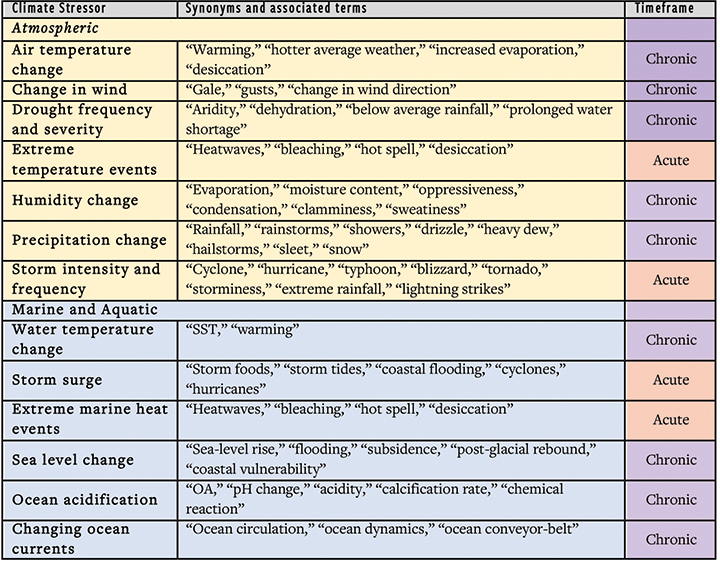
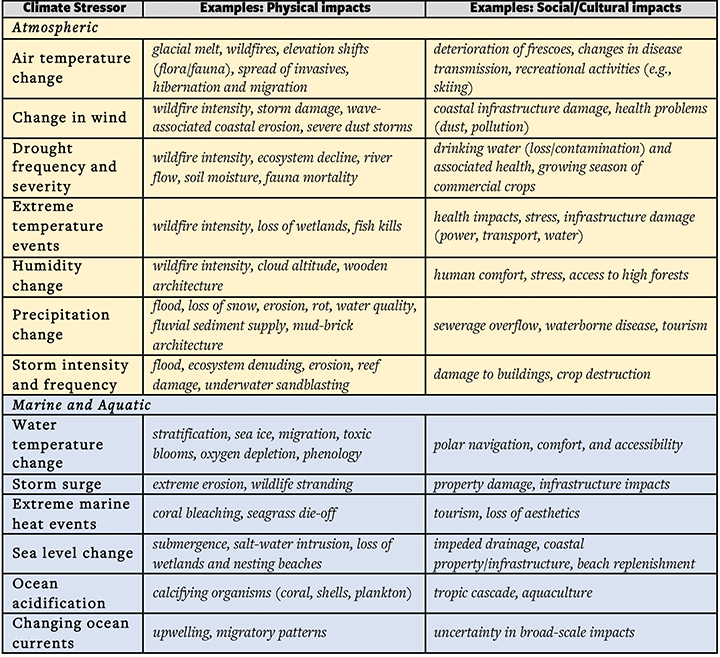
A key feature of the CVI is the systematic consideration of the ESC connections to assess the Community Vulnerability component. In each of these, we first consider the community’s current dependency upon the property and then evaluate the capacity to adapt in the future.
- Economic connections. These refer to the tangible (i.e., direct) economic value of business types directly associated with the World Heritage property (e.g., those operating inside the property boundary). We emphasize that this assessment is undertaken at the level of broad business types (e.g., day-tourism operations, multiday tourism trips, resorts, cruise ships, commercial fishing operations, tours, educational excursions, etc.) rather than for individual businesses. The economic dependency term describes the estimated future change in market economic value due to the key climate stressors, which may be negative or positive. Economic adaptive capacity considers how the identified business types are likely to cope (based on current capability) with anticipated future impacts of climate change. As the purpose of adaptive capacity is to mitigate (i.e., reduce) potential impacts, only one directionality (positive) is relevant.
- Social connections. These refer only to physical interactions of people with the property; i.e., individuals must have visited or used the property. The social dependency term describes the extent to which the key climate stressors will affect society now, and considers locals, domestic visitors, and international tourists separately. Social dependency can be assessed as either negative or positive. Social adaptive capacity (positive directionality) considers how the three societal groups are likely to cope, based on current capability, with anticipated future impacts of climate change.
- Cultural connections. These refer to affinities with the property and do not require a physical interaction with it; i.e., individuals need not have visited the property to have an affinity with it. The cultural dependency term describes the extent to which the key climate stressors will affect culture now, and considers locals, domestic visitors, and international tourists separately. Cultural dependency can be assessed as either negative or positive. Cultural adaptive capacity (positive directionality) considers how the three groups are likely to cope, based on current capability, with anticipated future impacts of climate change.
The CVI process weights each element equally; however, this may not best reflect the actual situation. For example, (1) for economic connections, there may be certain business types that are of greater economic importance; and (2) for social connections, one group (such as locals) may be considered of greater significance than others. Workshop participants are asked to evaluate whether the ESC outcomes need to be revised in light of these considerations. This opportunity for high-level revision ensures the final outcome reflects the proper levels of dependency and adaptive capacity for the community associated with the World Heritage property.
CVI workshops to date
Shark Bay, Western Australia was the first World Heritage property to trial the CVI. An initial workshop was held in September 2018 to assess the OUV Vulnerability (http://nespclimate.com.au/wp-content/uploads/2016/03/SBWH A-CC-workshop-report.pdf); a follow-up workshop in June 2019 completed the Community Vulnerability component (final report currently in preparation). Shark Bay includes exceptional natural features: vast seagrass beds, stromatolites (the oldest forms of life on earth), and several endangered marine and terrestrial mammals (https://whc.unesco.org/en/list/578). The two Shark Bay workshops:
- Identified the three key climate stressors as: air temperature change, extreme marine heat events, and storm intensity and frequency—considered over a time scale to ca. 2050;
- Determined that the OUV Vulnerability was rated as the highest category (“High”), based on the projected exposure, system sensitivity, and adaptive capacity; and
- Assessed the Community Vulnerability also to be “High,” acknowledging there was little ability of the community to cope with projected changes.
Heart of Neolithic Orkney (HONO) in Scotland was the first cultural World Heritage property assessed, during a three-day workshop in April 2019 (https://www.historicenvironment.scot/hono-cvi). HONO refers to a group of four Neolithic sites: an ancient settlement, a burial chamber, and two ceremonial stone circles (https://whc.unesco.org/en/list/514). Climate change has the potential for severe negative impacts on this 5,000-year-old site and the surrounding areas, given their location in the Orkney Islands. A key component of HONO, the prehistoric coastal settlement at Skara Brae, was itself discovered as the result of a storm in 1850, underlining the vulnerability of this site.
HONO was chosen as the first cultural World Heritage property to be assessed using the CVI for several reasons, including:
- The leadership and innovation in addressing climate change and its heritage implications by Historic Environment Scotland (HES), the public body responsible for the care and promotion of HONO;
- The engagement of the Archaeology Institute at the University of the Highlands and Islands and the Orkney community with their historic environment and archaeological activities; and
- Recently updated regional climate scenarios.
The CVI workshop for HONO:
- Identified the three key climate stressors as: precipitation change, sea-level change, and storm intensity and frequency—considered over a time scale to ca. 2050;
- Determined that the OUV Vulnerability was rated as the highest category (“High”), based on the projected exposure, system sensitivity, and adaptive capacity;
- Assessed Community Vulnerability as the middle category (“Moderate”), acknowledging the high level of adaptive capacity within the community; and
- Concluded that climate impacts are increasingly likely to add to a wide range of compounding pressures that collectively are impacting the islands themselves, and their heritage and cultural resources.
Both workshops identified a number of research gaps as well as various policy gaps, and guided the development of climate change adaptation strategies. Appendices to the HONO workshop report provide information that has assisted planning and preparation for subsequent CVI workshops.
Benefits of the CVI
Application of the CVI to date has demonstrated that it:
- Is a rapid assessment tool that works for, and is able to be consistently applied to, the full range of World Heritage properties (natural, cultural, and mixed).
- Is able to rapidly assess the physical and ecological impacts of climate change on a property’s OUV, but also provide a high-level assessment of the economic, social, and cultural consequences of climate change for communities that depend on an individual World Heritage property.
- Is scientifically rigorous, systematic, and comprehensive yet not overly complex (balancing scientific and political credibility with practicality at the property level).
- Is repeatable, allowing for assessments over time to assess trends (in the current era of rapidly changing climate, the ability to reassess vulnerability at periodic intervals in the light of new scientific understanding can guide updates of management actions).
- Is transparent, enabling others to see exactly how the assessment was derived.
- Puts climate change into context; i.e., climate change is becoming a dominant threat to many World Heritage values but is only one of many cumulative pressures affecting World Heritage properties in general.
- Provides opportunity toidentify adaptation strategies in the face of potential impacts, with a consistent methodology that supports applications for funds and other resources.
- Assists in better understanding by local and Indigenous communities and other users of World Heritage propertiesof climate change and its impacts (therefore it is a key engagement tool).
- Assists other World Heritage properties with similar values but less expertise to benefit from preexisting assessments.
- Is standardized, so that it can ultimately become part of World Heritage processes (such as State of Conservation reports, periodic reporting, and nominations).
Given the rapidly changing climate, three of the above features are particularly important. Firstly, the applicability of the CVI to all types of World Heritage properties means that it provides a standardized approach for assessing climate vulnerability. Secondly, the repeatability of the CVI means that changing conditions can be evaluated over a specified timeframe (e.g., 3–5 years), as can the effectiveness of management responses. Thirdly, the transparency of the CVI process means that the process can be rerun to test the sensitivity of the final outputs to different assessments of individual steps (by the same participants or a different group).
Widespread interest in the CVI has led to:
- Development of the CVI website (https://cvi-heritage.org/);
- Publication of a plain-English outline in The Conversation (https://theconversation.com/from-shark-bay-seagrass-to-stone-age-scotland-we-can-now-assess-climate-risks-to-world-heritage-119643);
- Numerous briefings for agencies and countries who are concerned about climate change impacts on their heritage; and
- Endorsement of the CVI by the Climate Change and Heritage Working Group of ICOMOS, and by the Protected Areas Climate Change Specialist Group of the IUCN World Commission on Protected Areas, both of whom have made it part of their current work program.
Applications of the CVI to date have led to proposals to integrate outcomes into relevant management plans, and to periodically repeat the process, enabling management that is responsive to changing future circumstances. The CVI process engages local community members in identifying key climate stressors and impacts, as well as offering opportunities for adaptation and impact mitigation for both the property itself and within the community. The systematic nature of CVI means that it can assist in prioritizing actions, help to strengthen community and institutional capacity, and improve protected area governance.
Where to next for the CVI?
The HONO workshop provided lessons for other heritage sites across Orkney and elsewhere in Scotland. HES has now recommended that the CVI process be repeated for HONO every five years, in parallel with the management review cycle. HES is also proposing to undertake CVI workshops for all Scottish World Heritage properties, with two further applications planned for 2020, and has noted that “the process is flexible and rigorous enough for much wider application and it is anticipated that others will find the format and process useful when considering the key values and climate change challenges at heritage sites worldwide.” For its part, the Shark Bay Advisory Committee is using the outcomes of the CVI process to inform development of their climate change adaptation strategy.
Several additional Australian World Heritage properties have expressed a strong interest in applying the CVI, as have others in Europe, the Americas, Asia, and the Middle East.
Applying the CVI beyond World Heritage
While the CVI was developed for World Heritage properties, the CVI framework has demonstrated its adaptability for other protected areas. The majority of protected areas have a statement describing the values for which they are recognized, akin to the statement of OUV for World Heritage properties. These statements can provide the anchor point from which the CVI process is applied.
Interest in the CVI has spread to managers of other types of protected areas. For example, the managers of National Trust properties in the United Kingdom are considering whether the tool might be useful for a wide range of their heritage interests. In addition, Indigenous groups associated with the Great Barrier Reef have expressed an interest in trialing the tool. IUCN has requested further work be undertaken to see how the CVI can inform its periodic assessment for the IUCN World Heritage Outlook.
Work is therefore currently underway to develop other delivery modes for the CVI process to provide a tiered set of rapid assessment options. The ”CVI Spectrum” (Figure 2) highlights three such options to assess aspects of the CVI. For example, the “CVI Snapshot” provides an initial assessment of only the vulnerability of key values within the CVI framework. This may assist in prioritizing which protected areas require a more comprehensive assessment, for which more time and resources are required. The “CVI Workshop” is the gold standard for assessing climate vulnerability using the CVI framework, as it applies all of the elements and draws upon the perspectives of a diverse group of participants.
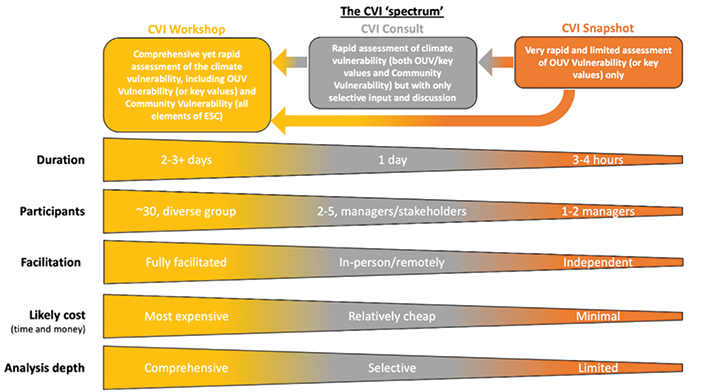
Conclusion
The CVI is increasingly being acknowledged across the international heritage community as providing a systematic assessment of the impacts of climate change upon World Heritage properties through a transparent and repeatable process. Applications of the framework have indicated that it can be adapted for use in protected areas beyond World Heritage, and there is substantial and growing interest to do so.
In the current era of rapid climate change, understanding vulnerability and identifying effective local management actions to build resilience of and mitigate impacts to protected areas is of utmost importance. However, for these special places to retain the values for which they were recognized, and to continue providing benefits to the global community, immediate and significant action on the causes of climate change must also be undertaken at national and international levels.
Author contributions
JCD and SFH contributed equally to the development of the CVI; JCD wrote the first draft of the paper, with all authors contributing revisions.
Jon C. Day, ARC Centre for Coral Reef Studies, James Cook University
Scott F. Heron, Marine Geophysical Laboratory, Physics, James Cook University
Adam Markham, Union of Concerned Scientists
Corresponding author:
Jon C. Day
ARC Centre of Excellence for Coral Reef Studies
James Cook University
Townsville, Queensland 4814
Australia
jon.day@my.jcu.edu.au
References
Bosson, J.B., Matthias Huss, and Elena Osipova. 2019. Disappearing World Heritage glaciers as a keystone of nature conservation in a changing climate. Earth’s Future 7(4): 469–479.
Day, Jon C., Scott F. Heron, Adam Markham, Jane Downes, Julie Gibson, Ewan Hyslop, Rebecca Jones, and Alice Lyall. 2019. Climate Risk Assessment for Heart of Neolithic Orkney World Heritage Property: An Application of the Climate Vulnerability Index. Edinburgh: Historic Environment Scotland. https://www.historicenvironment.scot/hono-cvi.
Heron, Scott F., C. Mark Eakin, Fanny Douvere, Kristen L. Anderson, Jon C. Day, et al. 2017. Impacts of Climate Change on World Heritage Coral Reefs: A First Global Scientific Assessment. Paris: UNESCO World Heritage Centre.
ICOMOS [International Council on Monuments and Sites] Climate Change and Cultural Heritage Working Group. 2019. The Future of Our Pasts: Engaging Cultural Heritage in Climate Action. Paris: ICOMOS.
IPCC [Intergovernmental Panel on Climate Change]. 2007: Climate Change 2007: Impacts, Adaptation and Vulnerability. Contribution of Working Group II to the Fourth Assessment Report of the Intergovernmental Panel on Climate Change. M.L. Parry, O.F. Canziani, J.P. Palutikof, P.J. van der Linden and C.E. Hanson, eds. Cambridge, UK: Cambridge University Press.
Markham, Adam, Elena Osipova, Kathryn Lafrenz Samuels, and Astrid Caldas. 2016. World Heritage and Tourism in a Changing Climate. Paris: UNESCO World Heritage Centre. https://whc.unesco.org/en/activities/883/.
Marshall, Nadine A., Renae C. Tobin, Paul A. Marshall, Margaret Gooch, and Alistair J. Hobday. 2013. “Social vulnerability of marine resource users to extreme weather events.” Ecosystems 16, no. 5: 797-809. DOI: 10.1007/s10021-013-9651-6
Osipova, Elena, Peter Shadie, Celia Zwahlen, Matea Osti, Yichuan Shi, Cyril Kormos, Bastian Bertzky, Mizuki Murai, Remco Van Merm, and Tim Badman. 2017. IUCN World Heritage Outlook 2: A Conservation Assessment of All Natural World Heritage Sites. Gland, Switzerland: IUCN. https://portals.iucn.org/library/sites/library/files/documents/2017-053-En.pdf.
Pecl, Gretta T., Miguel B. Araújo, Johann D. Bell, Julia Blanchard, Timothy C. Bonebrake, I-Ching Chen, Timothy D. Clark, et al. 2017. Biodiversity redistribution under climate change: Impacts on ecosystems and human well-being. Science 355(6332): 1–9; eaai9214.
Reimann, Lena, Athanasios T. Vafeidis, Sally Brown, Jochen Hinkel, and Richard S. Tol. 2018. Mediterranean UNESCO World Heritage at risk from coastal flooding and erosion due to sea-level rise. Nature Communications 9(1): 4161.
UNESCO [United Nations Educational, Scientific, and Cultural Organization] World Heritage Centre. 2007. Climate Change and World Heritage Report on Predicting and Managing the Impacts of Climate Change on World Heritage and Strategy to Assist States Parties to Implement Appropriate Management Responses. World Heritage Reports no. 22. Paris: UNESCO.



